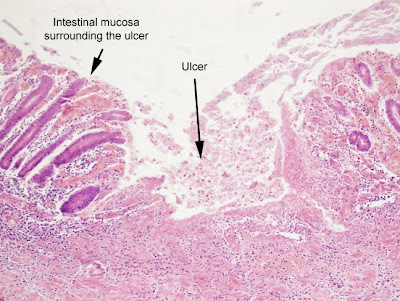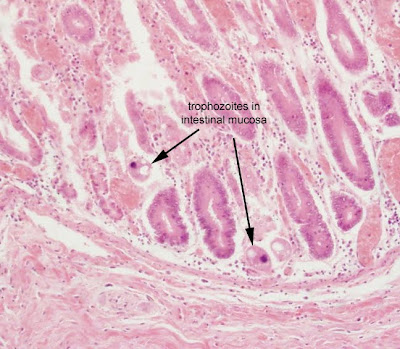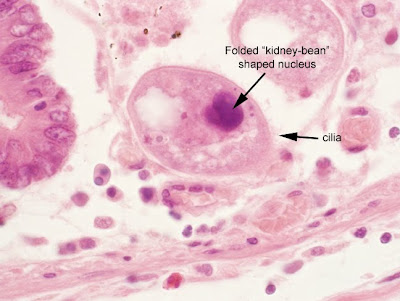Answer: Acanthamoebic keratitis
This is a case of keratitis caused by
Acanthamoeba species. These protozoan parasites are free-living amoebae found widely in the environment, such as in fresh water pools, soil, dust, and even chlorinated tap water. Keratitis usually occurs in patients that wear contact lenses, since the lens provides a nidus for irritation and infection. The classical history is that of a patient who wears contact lenses and rinses them in tap water or home-made saline solution.
The diagnosis is made by identifying classic cysts and/or trophozoites in corneal scrapings or biopsies, (histopathology, cytopathology, or microbiology preparations).
Acanthamoeba spp. can also be grown in culture or detected using fluorescent and molecular methods. Trophozoites measure approximately 15-45 µm, and produce many spine-like processes (acanthapodia) in culture. They differ from
Entamoeba histolytica trophozoites by having a large nucleus, large, centrally-located karyosome, and no peripheral chromatin. The cysts are typically 10-25 µm in diameter, and have a classic morphology, with a double-walled cysts. The outer wall (exocyst) is typically wrinkled, while the inner wall (endocyst) is hexagonal, spherical, or star-shaped. Like the trophozoites, the cysts contain one nucleus. CLICK ON IMAGES TO ENLARGE

Culture on tap water agar - See
Previous Case of the Week.
Another important differential diagnosis in this scenario is herpes keratitis caused by herpes simplex virus. One viewer commented that the organisms appeared to have the classic "marginated chromatin, glassy/cleared-out nuclei" of HSV-infected cells. This is particularly relevant in this case, since the cysts do not have visible nuclei. However, they can still be differentiated from herpes-infected cells by the presence of the wrinkled double walls. Also, the classic features (the 3 "M's") of herpes are not present - Multinucleation, nuclear Molding, and Margination of nuclear chromatin. Below is a classic case of a multinucleated herpes simplex virus-infected cell.

This patient with acanthamoebic keratitis did well after treatment, with little residual scarring. However, this is not always the case, and many cases of keratitis are very refractory to treatment.
A more deadly presentation of
Acanthamoeba spp. is chronic granulomatous encephalitis, a slowly progressive, often fatal infection of immunocompromised patients. Disease usually disseminates from a primary dermal or pulmonary source, cysts may be found in the skin, lungs and other organs.
Thanks to all who wrote in with comments!




+answer.jpg)
+answer.jpg)
+answer.jpg)
+answer.jpg)

.jpg)

.jpg)
.jpg)

